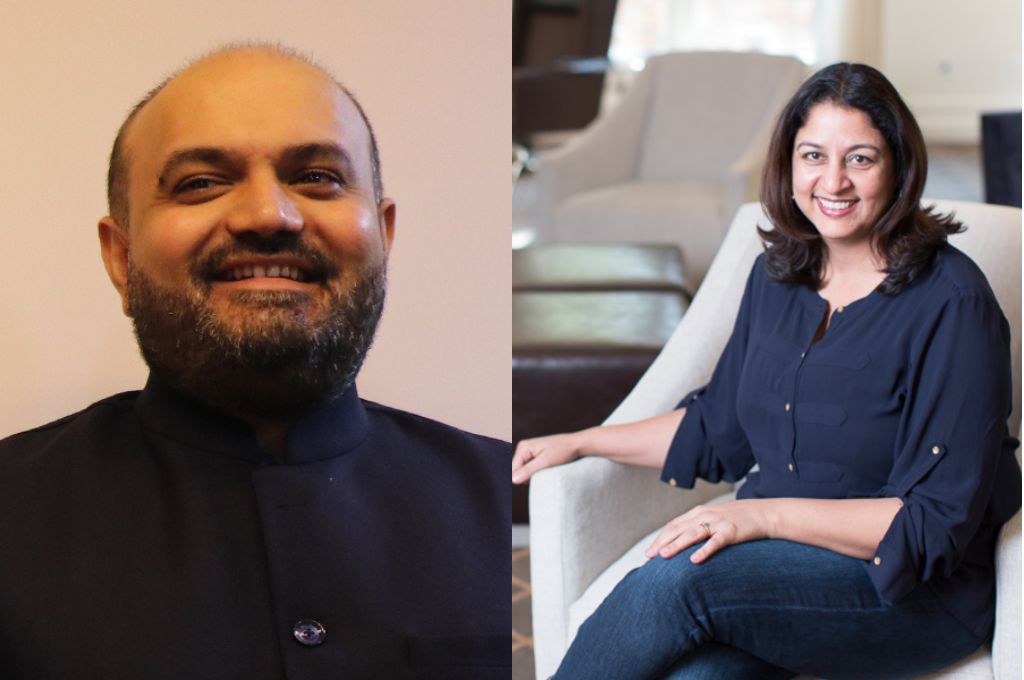Safeena Husain is the founder and Maharshi Vaishnav is the CEO of Educate Girls, a nonprofit established in 2007 that mobilises communities for girls’ education in India’s educationally backward areas.
In 2022, the organisation saw a leadership transition—Safeena stepped down from her role as CEO and Maharshi took over. Maharshi has been with Educate Girls for a decade, and previously served as chief of staff and COO.
In this interview with IDR, Safeena and Maharshi discuss why it was time for a change of leadership at Educate Girls, what the transition process looked like, and the challenges they both faced. They also share insights for organisations where leadership transitions are underway.


Tell us why this leadership transition happened when it did.
Safeena: I started thinking about this transition pretty early on, and we finally put it in our five-year strategy in 2017. This transition happened fairly early if you look at it in terms of organisational journeys. I believe that a founder can sometimes be the biggest bottleneck to an organisation’s growth or impact. Founders start organisations and then take them to a position from which they can scale rapidly. But it isn’t necessary that the founder has the skills that the organisation needs at that point. Educate Girls had been doubling in size every 18 months, and I knew that it needed a leadership with different skills than what I bring to the table.
Founders are good at finding a niche problem and building a solution for it. They have enormous capacity to absorb risk and try new things. I wanted to focus on those things rather than running a large machinery, which, beyond a point, I don’t have all the skills to do. That was the real thinking behind why we wanted a leadership transition.
What are some other steps that you took to initiate the leadership transition?
Safeena: Once we started planning the transition, Maharshi’s journey started to change fairly quickly. He moved from leading fundraising into a chief of staff role, then became the COO, and finally took on the role of CEO.
Maharshi: I wasn’t quite aware that this succession plan was put in place in 2017 or that Safeena was pursuing it actively. But Safeena was testing me gradually with greater responsibilities. So, from fundraising to communications to government relations—all external-facing aspects became my responsibility. Then, she floated this idea, “I’m looking for a chief of staff, would you be interested in it?” I asked her what that would mean and what I would have to do. She said, “You will be helping me with everything on a day-to-day basis.” So not just functional responsibilities, but an organisation-wide support system. I said that I hadn’t done this before, but would be happy to attempt it. That role opened my eyes to everything that was going on in the organisation—from HR, expansion, planning, operations, and impact to finance and budgeting. The three years as chief of staff were invaluable because they made me visualise the organisation in toto.
When our previous operations head left, Safeena suggested that I should run full-time operations. These smaller transitions over time prepared me to eventually become the CEO.

It wasn’t a direct transition. I was told, “You will be in the running, and we will have external experts who will work closely with the board to select the next CEO. But it’s yours to lose.” By that time, I’d worked with Educate Girls for close to eight years.
Safeena: I worked with a coach to help me visualise what my future looked like beyond Educate Girls. I felt very strongly that if I didn’t visualise a future for myself, I may never leave this job. We also developed talent internally. Apart from Maharshi, we built the ramp for others on the team to grow.
Later, we brought on Egon Zehnder, a leadership advisory firm, to create a formal process of transition along with a board subcommittee.
It isn’t very common to bring in a third party. How did that help and what were the advantages of doing so?
Safeena: As a founder you may decide that you want to do something and then just jump right into it. However, I found it very helpful to have an external party put a process to the transition. It made me slow down and take everyone along with me, particularly the board and the team. If I had just jumped into this transition, I would have created an enormous cliff for Maharshi to fall off from. His relationships with the board would have failed. But since we went through this exercise, everyone had time to process the change, explore all the possible avenues, and feel confident in the decision we were taking. So the process really enabled me to take everybody else along.
Secondly, I thought Egon Zehnder was coaching Maharshi to get on the road, but actually they were coaching me to get out of the road. Without that, I could have created a huge mess.
And since Maharshi’s role in the organisation had been through a few transitions, the team’s acceptance was almost seamless.

Maharshi, what did the change management process look like for you?
Maharshi: Since I had been at Educate Girls for many years when this transition began, I didn’t have to spend time getting to know the organisation or the sheer expanse of our operations. I could hit the ground running. However, I also had to step into Safeena’s shoes. So there was this constant, rather humbling realisation that I’m taking over from the founder.
The change process was essentially Safeena ceding control and me gaining it. And this manifested in many ways. In my very first meeting with our state operations team, when Safeena excused herself, I knew I had to shift from the rather demanding, hawkish lens that I had previously worn as the COO to a more mature, peacemaker role as the CEO.
Our partners and funders were curious about my plans and organisational vision. So I had to come up with business continuity plans in order to assuage them that we were very much in sync.
My mentors from Egon Zehnder—Govind Iyer and Namrita Jhangiani—put me through a rigorous 12-month programme to prepare me to take over as CEO. The first six months were all about what I was doing wrong. Then the next six months were about what I could do differently as CEO.
If I were to crystallise the core message that I received from Govind and Namrita, and also from Safeena and Ujwal Thakar—the chairman of our board—it was pretty simple. They were very clear that my style of functioning, leadership, delegation, culture setting, etc., was bound to be different from Safeena’s. So they suggested I give the team ample time to acclimatise to my ways.
Stick to the basics and don’t try anything outrageous right at the start.
I was also asked to stick to the basics and not try anything outrageous right at the start. Do not underestimate the importance of the first few months. Even though I’m an insider, context is always critical, so I had to take time to set the context for all concerned stakeholders, internal and external. My former peers were now my reportees, so I had to maintain a professional relationship with all. Consistency of messaging is critical.
It sounds like it’s been a smooth transition, but there can be no change without challenges. Could you speak about the challenges you faced during the transition? And, Safeena, what was it like to let go of the reins?
Safeena: After the first board meeting with Maharshi as CEO, Ujwal took me aside and gently gave me this piece of feedback, “You are not supposed to do this any more. You are not supposed to say this any more.” And I said, “I don’t get it. What do you want me to do? What am I there for in the board?” And he just said, “I want you to come to the board meetings, but I don’t want you to say anything.” So I was getting reality checks from board members saying, “You have a new corner, stay there.” I will probably continue to forget, and people will hopefully keep telling me and pushing back at the right time.
Eventually I had to remind myself that I did this for a reason and now I’m free to do what I have been wanting to do, which is to grow the second-chance programme for marginalised adolescent girls. Since Maharshi took over, I’ve been able to spend a substantial amount of time in the villages, sitting with girls, and getting that ground-zero view. I’m hoping that, this time, I will minimise the mistakes I made 15 years ago when we started Educate Girls. Since the transition, I’ve spent 50 percent of my time on the field, absorbing and talking, and enjoying being outside the corporate office and building the next big thing. So I feel immensely grateful to Maharshi.
Maharshi: It’s been an endless series of epiphanies for me. The fundamental premise of Educate Girls is to help the most marginalised girls get back to school. Nothing changes there. But in my previous roles as chief of staff and COO, my perspective was different. Safeena was always there to shield me. Now that I am the one who’s ultimately accountable, it’s less about quick fixes and more about trial and error. It’s always about the root cause analysis. I find myself asking, what is the plan B, C, or D?
Let’s say in Rajasthan we have saturated our targets. So what happens with the government, which still wants us to operate in the state? What happens to our local team and the communities they work with? So my perspective has shifted.
And as far as challenges are concerned, there is not a single day when I’m not reminded of the fact that we have 2,700-plus employees and 17,000-plus team members. They have invested their lives and careers with us so that we achieve our mission. How do we build an organisation that’s values-driven and mission-aligned, and is centred around the girl child? Rajasthan, UP, MP, and Bihar all come with their set of challenges of working with government, funders, etc. So, it’s a mixed bag.
What are some dos and don’ts for other Indian nonprofits that may be looking to go through a similar process?
Safeena: I would say design for it, and do so really thoughtfully; take your time, as this isn’t something that can happen overnight. Do it for the right reasons. Ask yourself why you really want to do this. If you don’t do it for the right reasons, then it’s going to be miserable for you and for the person who comes into the role.
The other important piece has to do with communication. We deliberated on every single word of the e-mail we drafted for the leadership change announcement. Before the announcement, I spoke with every donor and told them what was about to happen. In these situations, overcommunication is preferable. And it’s important to take everybody along with you.
Maharshi: First and foremost, prepare for it. You won’t be able to slide into the founder’s shoes overnight. When Safeena and Ujwal informed me about the date of announcement and told me that they were going to inform the funders in advance, get the team together, and make a video message for the field teams, it was unnerving for me.
The founder is a different individual and you must not attempt to emulate them.
The founder is a different individual and you must not attempt to emulate them. Emulating best practices is fine, but don’t try to be that person. Stay true to your personality. As long as you are aligned with the vision and the mission of the organisation, you’re trying to perpetuate the vision that the founder had set for the organisation.
Govind kept asking me, “This is Safeena’s organisation, how are you going to make it your organisation?” So I said, “I’m going to make it my organisation by running it the way I want to run it.” But the end goal of facilitating the enrolment of 1.56 million girls by 2025 is not going to change. Perhaps the pathway to it could be mine and it could be my team implementing the plan, but nothing else changes.
—
Know more
- Read this article to learn how to make a smooth leadership transition in nonprofits.
- Understand why a new-leader pitch is important and learn what it should include.





